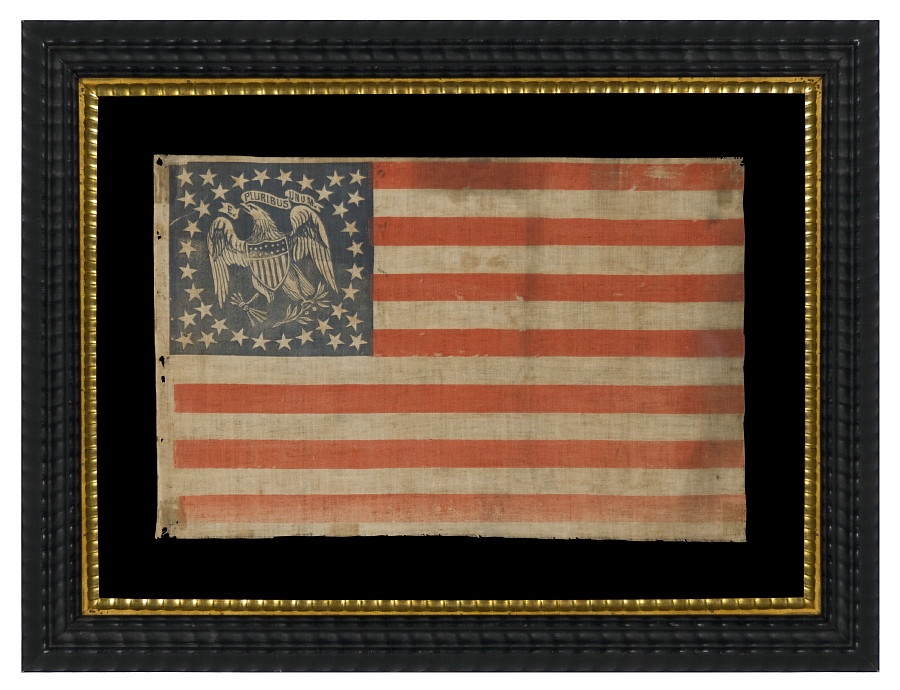
| |
EXTREMELY RARE PARADE FLAG WITH 36 STARS AND AN EAGLE IN THE CANTON, AN IMPORTANT, UNDOCUMENTED EXAMPLE AND THE ONLY ONE OF ITS KIND KNOWN TO EXIST IN THIS STAR COUNT |
|
| Available: |
Sold |
| Frame Size (H x L): |
18" x 23.5" |
| Flag Size (H x L): |
10.5" x 16.25" |
|
| Description....: |
|
EXTREMELY RARE PARADE FLAG WITH 36 STARS ANDAN EAGLE IN THE CANTON, AN IMPORTANT, UNDOCUMENTED EXAMPLE AND THE ONLY ONE OF ITS KIND PRESENTLY
KNOWN TO EXIST:
36 star American National parade flag, printed on cotton. In the center of the canton is a prominent eagle with a shield on its breast, arrows and olive branches in its talons, and banner in its beak that reads "E. Pluribus. Unum." (out of many, one). A large, single wreath of 24 stars surround the image and a triangle of 3 stars flanks the basic pattern, one in each corner. A typical medallion pattern will have two or three consecutive wreaths of stars, with a single flanking star in each corner. Here the presence of the large eagle leaves room for only a single wreath, which required that more stars be incorporated outside its perimeter to achieve the desired star count.
Parade flags that incorporate large eagles as a prominent feature in their design are among the rarest of all printed flags. I have owned five such examples, including this one, and am aware of about ten in total that are known to have survived from the 19th century to the present. Six of these are in a style very similar to this one, but with a slightly different eagle and a different star arrangement. One of the six is nearly identical in scale to this flag, while the remaining five are about half the size. All were likely produced by the same flag-maker.
It is interesting to note that two of the similar 35-star examples have an inked, "Lincoln & Johnson" overprint, for use in the 1864 presidential campaign. Lincoln is known to have used both 35 and 36-star parade flags in the 1864 campaign and, given their rarity, it is feasible to suggest that the examples with eagles, both with and without overprints, were probably made for Lincoln rallies. Parade torches exist, made with eagles in a similar style, that are identified to torch-lit Lincoln campaign parades.
So in summary, this is the only known example of its kind, with a Civil War era date, a probable Lincoln association, and with one of the rarest and most desirable types of imagery that exists in early American parade flags.
The 36th state, Nevada, entered the Union during the Civil War on October 31st, 1864. The last Confederate general surrendered on May 26th, 1865. The 36 star flag became official on July 4th of that year, but makers of printed flags would have begun adding a 36th star to their flags in 1864, even before the addition of the new state occurred. Lincoln pushed Nevada through just 8 days before the November election. Nevada's wealth in silver was attractive to a nation struggling with the debts of war and increased support for the Republican ticket. The 36 star flag was replaced by the 37 star flag in 1867, with the addition of Nebraska.
Mounting: The ripple-profile frame has a gilded liner and dates to the period between 1830 and 1860. The flag has been hand-stitched to 100% cotton, black in color, which has been washed and treated to reduce excess dye. An acid-free agent was added to the wash to further set the dye and the fabric was heat-treated for the same purpose. Spacers keep the textile away from the glass, which is U.V. protective.
Condition: There is minor to moderate soiling, accompanied by minor fading and some fraying. There are tack holes along the hoist end, where the flag was formerly affixed to a wooden staff. The flag presents extremely well and its great rarity warrants any condition. |
|
|
|
| Collector Level: |
Flags for the truest Patriots. My best offerings |
|
| Flag Type: |
Parade flag |
|
| Star Count: |
36 |
|
| Earliest Date of Origin: |
1864 |
|
| Latest Date of Origin: |
1867 |
|
| State/Affiliation: |
Nevada |
|
| War Association: |
1861-1865 Civil War |
|
| Price: |
SOLD |
|
| |
Views: 3337 |
|
|
|

